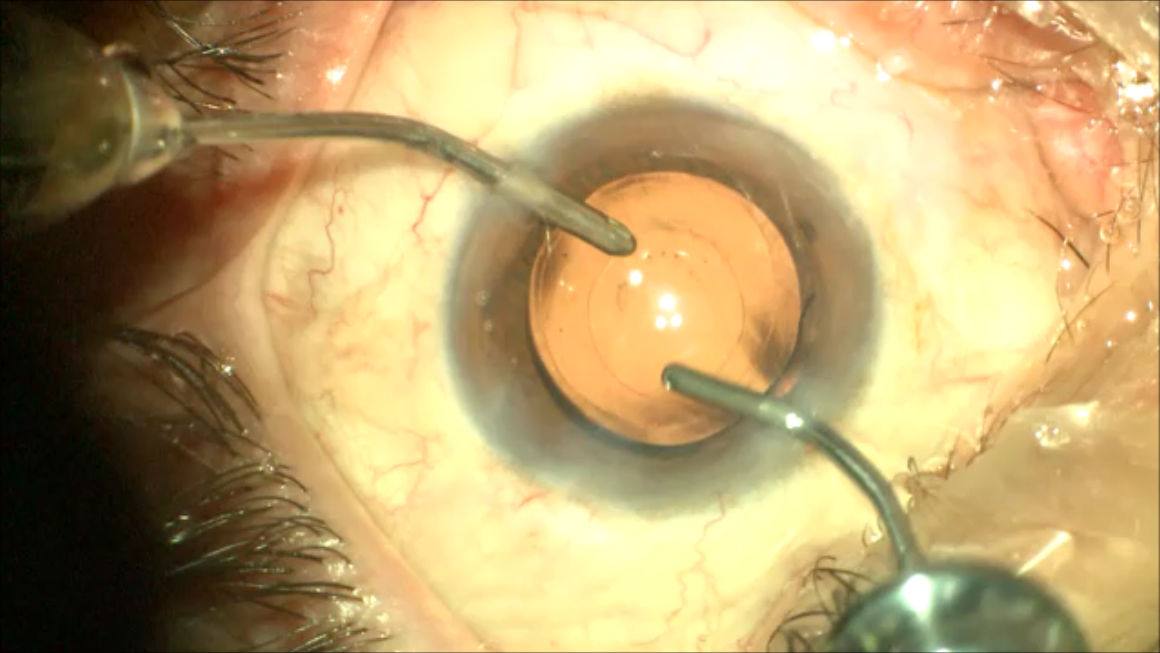Prevention and Treatment of Posterior Capsule Opacification Following Artificial Lens Implantation

Posterior Capsule Opacification (PCO) or Posterior subcapsular cataract (PSC) is a disease characterized by opacification and loss of transparency of the posterior capsule of the lens, which develops either primarily or secondarily after surgical treatment of primary cataract and causes decreased visual acuity and reduced contrast sensitivity. Despite significant progress in cataract surgery, secondary PCO remains a significant challenge for clinical medicine and healthcare. This paper reviews the pathogenesis of the disease and modern preventive and therapeutic strategies, focusing on the design and material of the artificial intraocular lens, as well as laser and surgical techniques and pharmacotherapy. From a preventive point of view, the association of acrylic and silicone, hydrophilic and hydrophobic lenses with the development of secondary PCO and the need for additional treatment is compared. Surgical preventive approaches aim to minimize the lens epithelial cells and their proliferation potential, which can be achieved by thorough cleaning-polishing of the cortical masses, hydrodissection or posterior capsulorhexis, the latter of which is of particular interest. Pharmacotherapeutic approaches are still only theoretical in nature. It should be emphasized that the existing data need to be clarified by additional studies. Regarding treatment, the Nd:YAG laser posterior capsulotomy method is discussed with its solution and current challenges. Since PCO remains a significant challenge in ophthalmic surgery, it is important to have an interdisciplinary approach to improve lens design and materials, as well as to thoroughly research and refine less studied preventive approaches.
Downloads
Metrics
No metrics found.
Aykan U, Bilge AH, Karadayi K, Akin T - The effect of capsulorhexis size on development of posterior capsule opacification: small (4.5 to 5.0 mm) versus large (6.0 to 7.0 mm)- July 1, 2003 DOI: 10.1177/112067210301300606
Biswas P, Batra S. Commentary: Anterior capsule polishing: The present perspective. Indian J Ophthalmol. 2020 May;68(5):785-786. doi: 10.4103/ijo.IJO_2088_19. PMID: 32317446; PMCID: PMC7350444.
Čanović S, Konjevoda S, Didović Pavičić A, Stanić R. Intraocular Lens (IOL) Materials [Internet]. Intraocular Lens. IntechOpen; 2020. Available from: http://dx.doi.org/10.5772/intechopen.89985
Cooksley G, Lacey J, Dymond MK, Sandeman S. Factors Affecting Posterior Capsule Opacification in the Development of Intraocular Lens Materials. Pharmaceutics. 2021 Jun 10;13(6):860. doi: 10.3390/pharmaceutics13060860. PMID: 34200928; PMCID: PMC8230425.
Delbarre M, Froussart-Maille F. Sémiologie et formes cliniques de la cataracte chez l’adulte [Signs, symptoms, and clinical forms of cataract in adults]. J Fr Ophtalmol. 2020 Sep;43(7):653-659. French. doi: 10.1016/j.jfo.2019.11.009. Epub 2020 Jun 22. PMID: 32586638.
Derek W DelMonte, MD, Kourtney Houser, MD, Caroline Awh, Jeffrey M Goshe, Bharat Gurnami MBBS,DNB,FCRS, FICO (UK), MRCS (Ed), MNAMS - Posterior Capsule Opacification – January 13, 2022. - https://eyewiki.aao.org/Posterior_Capsule_Opacification.
Fang, R., Yu, YF., Li, EJ. et al. Global, regional, national burden and gender disparity of cataract: findings from the global burden of disease study 2019. BMC Public Health 22, 2068 (2022). https://doi.org/10.1186/s12889-022-14491-0
Hashemi H, Pakzad R, Yekta A, Aghamirsalim M, Pakbin M, Ramin S, Khabazkhoob M. Global and regional prevalence of age-related cataract: a comprehensive systematic review and meta-analysis. Eye (Lond). 2020 Aug;34(8):1357-1370. doi: 10.1038/s41433-020-0806-3. Epub 2020 Feb 13. PMID: 32055021; PMCID: PMC7376226.
Hecht I, Dubinsky-Pertzov B, Karesvuo P, Achiron A, Tuuminen R. Association between intraocular lens diopter and posterior capsular opacification. Clin Exp Ophthalmol. 2020 Sep;48(7):889-894. doi: 10.1111/ceo.13821. Epub 2020 Aug 6. PMID: 32639048.
Jagat Ram, MD, Suresh K. Pandey, MD, David J. Apple, MD, Liliana Werner, MD, PhD, Gagandeep S. Brar, MD,Ramandeep Singh, MD, Kulbhushan P. Chaudhary, MD,Amod Gupta, MD - Effect of in-the-bag intraocular lens fixation on the prevention of posterior capsule opacification - J CATARACT REFRACT SURG—VOL 27, JULY 2001 DOI:10.1016/S0886-3350(00)00841-5
Lisanne M.NibourgabcEdithGelensdRoelKuijerceJohanna M.M.HooymansacTheo G.van KootenceSteven A.KoopmansacPrevention of posterior capsular opacificationhttps://doi.org/10.1016/j.exer.2015.03.011
Mcdonald, Matthew. (2021). Posterior Capsule Opacification. 10.1007/978-3-030-38234-6_12.
Menapace R. Posterior capsulorhexis combined with optic buttonholing: an alternative to standard in-the-bag implantation of sharp-edged intraocular lenses? A critical analysis of 1000 consecutive cases. Graefes Arch Clin Exp Ophthalmol. 2008 Jun;246(6):787-801. doi: 10.1007/s00417-008-0779-6. Epub 2008 Apr 19. PMID: 18425525; PMCID: PMC2367393.
Schultz, Tim & Schojai, Merita. (2024). Primary posterior laser capsulotomy (PPCL) after cataract surgery: 2-year results. 10.21203/rs.3.rs-4074558/v1.
Shaaban Abd-E;hamid Elwan, Ahmed M. Eid, Ahmed M. Sabry, Novel Technique of Pneumatic Posterior Capsulorhexis for Treatment and Prevention of Posterior Capsular Opacification, Hindawi, Journal of Ophthalmology, Volume 2019, Article ID 3174709, 6 pages https://doi.org/10.1155/2019/3174709
Shin KS, Park HJ, Jo YJ, Kim JY. Efficacy and safety of primary posterior capsulotomy in combined phaco-vitrectomy in rhegmatogenous retinal detachment. PLoS One. 2019 Mar 8;14(3):e0213457. doi: 10.1371/journal.pone.0213457. PMID: 30849095; PMCID: PMC6407776.
Sophie Maedel Jennifer R Evans Annette Harrer-Seely Oliver Findl - Intraocular lens optic edge design for the prevention of posterior capsule opacification after cataract surgery - 16 August 2021DOI: 10.1002/14651858.CD012516.pub2
Storey P, Munoz B, Friedman D, West S. Racial differences in lens opacity incidence and progression: the Salisbury Eye Evaluation (SEE) study. Invest Ophthalmol Vis Sci. 2013 Apr 26;54(4):3010-8. doi: 10.1167/iovs.12-11412. PMID: 23572101; PMCID: PMC4597483.
Tanja M.Rabsilber MD,II-Joo Limberger MD, Andreas J. Reuland MD, Secondary Cataract Prevention,Vol.114,p397-398,DOI: https://doi.org/10.1016/j.ophtha.2006.08.001
Ursell PG, Dhariwal M, O'Boyle D, Khan J, Venerus A. 5 year incidence of YAG capsulotomy and PCO after cataract surgery with single-piece monofocal intraocular lenses: a real-world evidence study of 20,763 eyes. Eye (Lond). 2020 May;34(5):960-968. doi: 10.1038/s41433-019-0630-9. Epub 2019 Oct 15. PMID: 31616057; PMCID: PMC7182577.
Ye Rin Kwon, Yoo Na Hwang, and Sung Min Kim - Posterior Capsule Opacification after Cataract Surgery via Implantation with Hydrophobic Acrylic Lens Compared with Silicone Intraocular Lens: A Systematic Review and Meta-Analysis - Received 5 August 2021; Accepted 26 January 2022; Published 25 February 2022 – DOI: 10.1155/2022/3570399
Zhang Y, Jiang J. Advances in interdisciplinary medical and engineering research of intraocular lens surface modifications to prevent posterior capsule opacification. Zhong Nan Da Xue Xue Bao Yi Xue Ban. 2022 Dec 28;47(12):1754-1762. English, Chinese. doi: 10.11817/j.issn.1672-7347.2022.220277. PMID: 36748388; PMCID: PMC10930271.
Copyright (c) 2025 Georgian Scientists

This work is licensed under a Creative Commons Attribution-NonCommercial-NoDerivatives 4.0 International License.





